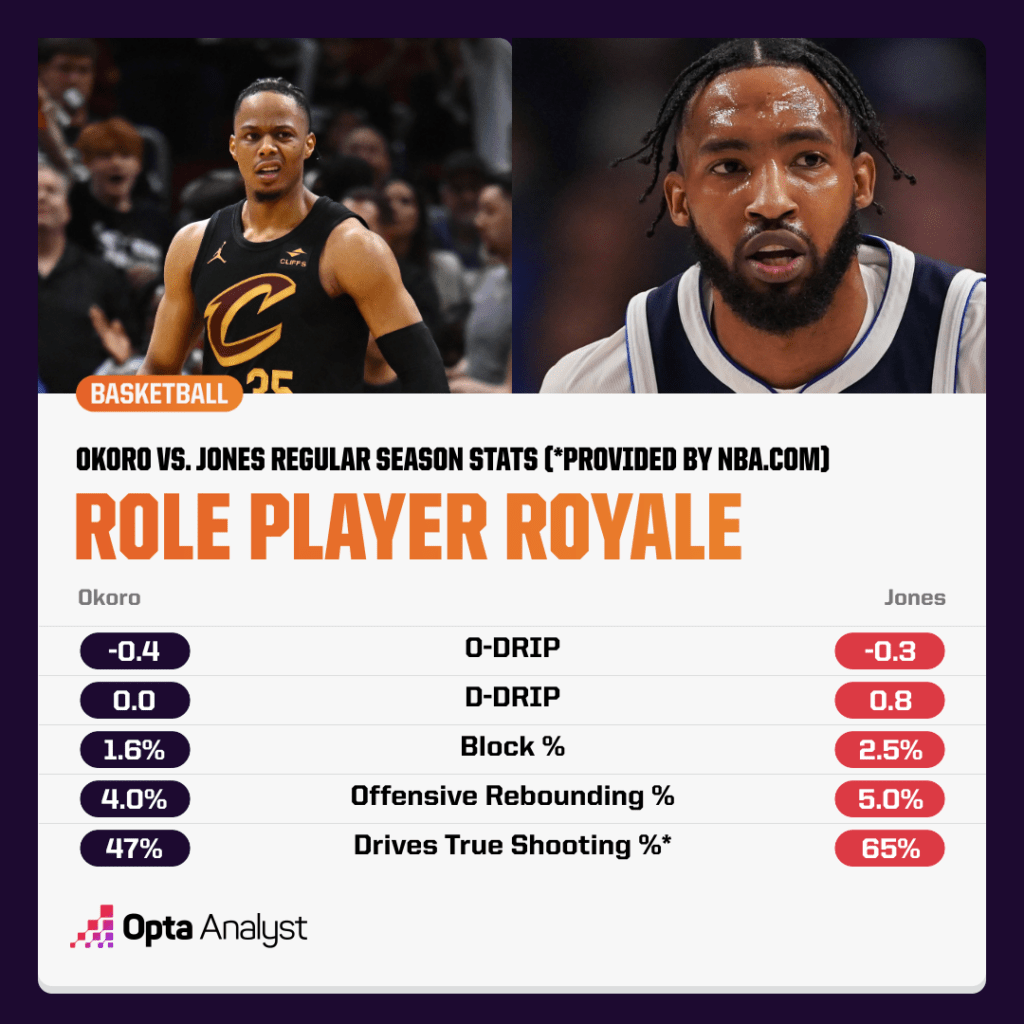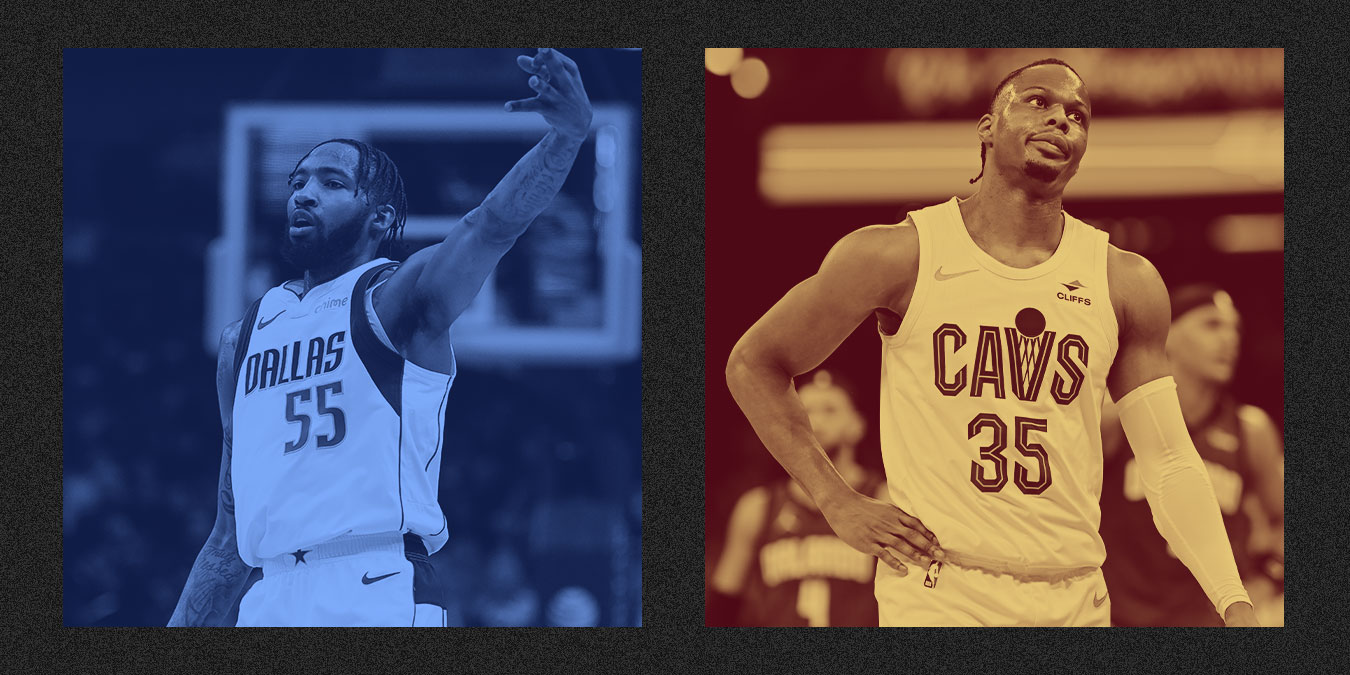To be blunt, the title of this article is a little misleading.
We aren’t discussing all NBA role players, just a very specific (and very important) type of player. The article itself is also a little self-indulgent: This type of role player is one I have devoted many hours of my basketball life studying.
In multiple articles this season – like our deep dive on Ausar Thompson – we’ve spent time examining the defense-first, below-average shooting wing/forward archetype.
Every year, a handful of these players find themselves on NBA playoff rosters. And every year, like clockwork, some succeed, while others are relegated to the bench.
But why? What factors have led to different outcomes for similar players?
Below, we will try to answer that question – through the lens of the Cleveland Cavaliers’ Isaac Okoro (a playoff casualty) and the Dallas Mavericks’ Derrick Jones Jr. (a playoff thriver).
Okoro and Jones in the NBA Playoffs
Just in case you haven’t been intensely watching Okoro and Jones in their minutes on the court this postseason – if you aren’t, you’re missing out – let’s quickly paint the picture of what’s been going on with them.
In 12 playoff games, Okoro averaged 21.9 minutes and 5.5 points per game on 44.6% true shooting with a -3.7 net rating. Meanwhile, in 11 games, Jones is averaging 29.6 MPG and 9.8 PPG on 57.2% true shooting with a 2.8 net rating.
Do you see the difference?
NBA Role Players: Defense, First
The first key to this player type surviving in the NBA playoffs is to be an impactful defender (duh). But a player can’t just be a good defender, he needs to be a good enough defender to make up for any negative offensive impact.
Okoro is a good defender, but not strong enough to make up for his poor offensive contributions. We can get a sense of this by looking at his impact statistics – particularly our DRIP metric, which projects a player’s contribution to a team’s plus/minus per 100 possessions.
According to DRIP, Okoro is a neutral defender (0.0 D-DRIP), and his offense is a net negative (-0.4 O-DRIP). That means he’s an overall negative on his team (-0.4 DRIP).
That is fine for the regular season, but it can be damaging in the playoffs – as evidenced by the Cavaliers’ second-round elimination, albeit to the Boston Celtics, the NBA’s best team during the regular season.
Juxtapose Okoro with Jones to see a difference – Jones is a clear positive on defense (0.8 DRIP), enough so to counterbalance his negative offense (-0.3 O-DRIP) and create an overall positive DRIP of 0.5.
That brings us to the next question: How is Jones such a better defender than Okoro?
Evaluating defense is a very fickle endeavor. To properly analyze it, you need copious hours of film study and data inquiry. To summarize it into a few sentences is oftentimes disingenuous, but in this specific situation, I think it’s appropriate.
The key difference between Jones and Okoro on defense is athleticism. Okoro is a very good athlete, even relative to NBA standards, but Jones falls under the freak athlete designation. After all, he was the winner of the 2020 NBA Slam Dunk Contest.
Jones’ built-in springs enable him to offer the most important ingredient to defense: rim protection. To date, his block rate in the playoffs is 4.5%, while Okoro finished his postseason at a mere 1.5%.
Here are some instances of Jones “going upstairs”:
The secondary rim protection Jones adds to the equation is a big reason why the Mavericks are fourth in the playoffs in opponent points in the paint per 100 possessions (per NBA.com) despite playing one of the best paint-scoring teams (the Oklahoma City Thunder) for five of their 11 games.
NBA Role Players: Offense, Too
When we looked at their respective DRIP output, you may have noticed Jones has a slightly better O-DRIP than Okoro. This margin gets at the other part of the difference in their playoff experience: Even if a large portion of a player’s value is derived from defense, he still needs to offer something offensively.
Neither of these players are even average shooters. In the playoffs, teams sag off them to protect the paint and closeout short to them when the ball streamlines in their direction. That’s the main reason they are in this mess in the first place.
Battling these defensive tactics isn’t easy. It takes confidence and decisiveness. A player in these situations needs to swiftly drive these short closeouts and find his way to the rim, regardless of what may be lurking on the interior. Look how fearless Jones is when he’s attacking off the catch (the first clip in the montage below), and inversely, look how disjointed (and ineffective) Okoro is when attempting the same feat (the second clip):
This postseason, Jones has a true shooting mark of 56% on his drives to the basket – five percentage points higher than Okoro’s playoff true shooting on drives. An even greater disparity exists in their regular-season averages – Jones averaged 65% true shooting on drives, while Okoro was at a measly 47%.
Jones’ athleticism plays a factor in this area, too. Jones can transcend abbreviated closeouts and packed paints with his 99th percentile burst and verticality. Those features also help him be a more-effective offensive rebounder than Okoro – he has a 6.1% offensive rebound rate compared to Okoro’s 2.2%, which is another way for this player type to juice his offensive value (because offensive rebounds create more shot attempts for the team).
Also, when Jones secures a second chance opportunity, he doesn’t always need to kick the ball out to Luka Doncic or Kyrie Irving. Sometimes, he can leverage his heroic hops to author a punctuating putback jam, like this:
We’ve already alluded to this ad nauseam, but just to hammer home the point, this season, Jones was way ahead of Okoro on dunks, 62 to 18.
The Answer
What have we learned from all of this?
The main takeaway is this type of role player needs to not just be a good defender but a great one, and he also needs to provide some offensive utility. On defense, it really helps if the player can provide strong secondary rim protection. On offense, the ability to drive closeouts and create second chance opportunities is paramount.
This all sounds good after the fact, but how can we use these lessons to instruct our inferences on the future?

Well, if you look at Jones and Okoro’s regular-season numbers, the differences were always there. Jones had the higher D-DRIP, O-DRIP, block rate, true shooting on drives and offensive rebounding percentage.
It’s just as Woody Harrelson’s character in “True Detective” said, “You know the detective’s curse? The solution was right under my nose, but I was focused on the wrong clues.”
It’s the same scenario with these two NBA role players – the signs were right there all along.
Jones was always going to be the one who had the better postseason than Okoro.
Check out our MLB, NBA and NFL coverage. Follow us on X and Instagram for more!
